Publishing under the red veil
The diversity of paratexts of Slovak translations of Dutch literature in communist Czechoslovakia
In this cluster, we are going to take a closer look at the publishing of Dutch literature in the period of 1945-1989. It should be mentioned, that we are going to be talking about a different situation and conditions than in many other countries, since for the most time of this period, Czechoslovakia was under the government of Komunistická strana Československa (further named KSČ). We are not going to analyse the regime and all of their actions, but rather focus on the aspects connected to the literary field and the book publishing practices. The KSČ wanted to control the most important matters in the country, which are industry, finances and politics, but neither did they forget about a very powerful tool of a nation – its literature. Literature has a very strong influence on the population, thus controlling literature meant impacting the general thinking of citizens.
„Tools“ of the government
The KSČ, did not have an impact directly on the spot, but through organizations with an impact on what can and cannot be published, such as Zväz československých spisovateľov, the society of Czechoslovak writers, where translators had their own section. On one side, they offered funds to support writers and other art sectors, which were previously underfinanced, but on the other side, literature became more dependent on this financing, which lead to a certain loss of artistic freedom. This phenomenon is called „nationalisation“ of the distribution and publishing of literature. The idea behind this was that the writers themselves, through authors organizations, should decide what books should be printed, which means that literature would no longer adapt to trends in literature, but rather focus on national literature. But we should ask ourselves a question – should literature be guided? A free market with healthy competition offers the readers what they want most, whether that is for example a translation of a popular book from abroad or domestic literature - a book from a Czechoslovakian author - literature market simply adapts to the demands of the readers. Apart from the strict rules of publishing, the government could influence the future development of literature through other ways. One such way was the distribution of paper. To someone from abroad it may seem absurd, but the paper factories were under state control, so the government also decided how much paper a publisher could receive. Cooperative publishers, agreeing to the dominant ideology of socialistic realism, received more funding and also paper, which allowed them to publish on a greater scale than the others. Publishers that did not abide to the rules or dared out to speak against the rules, were often met with confiscation of property and its transfer to the hands of the state. The property was then managed by a „národný správca“ (freely translated as a national administrator), which was usually a person more willing to cooperate, or even a supporter of the current regime. By these actions, the power of the regime was slowly, but surely increasing.
Paratexts: everything concerning a book
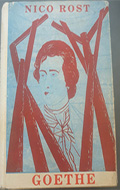
Goethe in Dachau
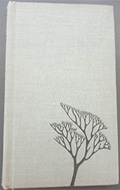
Now that we are familiar with the publishing situation in Czechoslovakia, we would like to discuss the paratexts of Slovak translations of Dutch literature. As we already know, we cannot speak of a regular free market, where publishers compete between each other to be successful. But despite this fact, we can still find a huge variety of paratexts – aspects of a book which are meant to attract the potential reader and provide information about the book or author’s life. So the question arises – why was there such a variety? Dutch literature in that period was not so well-known in Czechoslovakia, so through the use of paratexts, for example a nicely designed cover, people could notice the book and perhaps decide to learn more about it. That is when the other types of paratexts come into play – interesting facts about the author or in some cases illustrations. Another type of paratexts which appeared frequently were forewords. They were often written by the translator and in some cases also mentioned the regime’s most respected values, of course only in a positive way. For example if the book’s main protagonist shared the qualities of an ideal socialistic hero, they were brought up and put on a pedestal.
What we also found out is that a lot of the illustrations and covers were created by successful graphic designers and artists, such as Ladislav Guverna, a surrealistic painter, who has also received international awards for his works of art. As long as the illustration was not depicting the politic regime in a negative way, the publisher had a free hand. We cannot speak about a specific style, since every publisher had a different style. In the case of the book Goethe – Nico Rost, we can see that the cover is totally different than the original – we can see a surrealistic design. Below, you can see two very different types of covers, one of the already mentioned book Goethe and one very simple and basic, the cover of Kamenné svadobné lôžko (Het Stenen Bruidsbed) by Harry Mulisch, which bears almost no information that could attract the potential reader. Mulisch was not particularly a welcomed author for the communist regime, which may explain the unattractive cover presented with caution to the Slovak readership. Rost on the other hand, was an left-wing Dutch author who wrote his Dachau diary and was sent to this camp because of his political thoughts.
The regime also came with a phenomenon typical to communistic countries – having everything under your thumb, although sometimes indirectly. As we already mentioned, there was no official censorship, so how could the government influence what can and cannot be published? Very easily – through distributing paper needed for printing only to „cooperative“ publishers. That way, they did not have to worry about someone throwing a shade at the regime. The following photo of paratextual information belongs to the book Ženy do Jacatry (Vrouwen naarr Jacarta), written by Ary den Hertog. At first it does not seem like anything special can be found there, but upon a closer look, almost at the bottom, there is a small number which indicates the following code: povol. SÚKK – č. 46/I – OR – 1972, which meant that the Slovak authority for book culture – a censorship agency - had agreed to the publishing of this book in the year 1972.
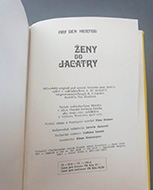


Another type of paratext we came across was the book quota, which basically meant that a government institution gave the publisher a number of books that are to be printed. This was not based on the expected interest of the readers, but had more common with the central planning of communism – making plans for the future, what is to be manufactured and sold, sometimes for as long as 5 years ahead. Below you can see a very huge difference in the total amount of printed books. The first picture shows the quota of the book Juhoafrická únia dnes (de Unie van Zuid-Afrika vandaag), written by G. H. Van Der Merwe and the second of a series of collected stories written by Faber and Heere Heeresma. The reason behind this might be that the book Juhoafrická únia dnes is more of an academic title, more suited for academics (translated academic literature) than the general public, whereas the other book consists of stories meant to entertain the reader.

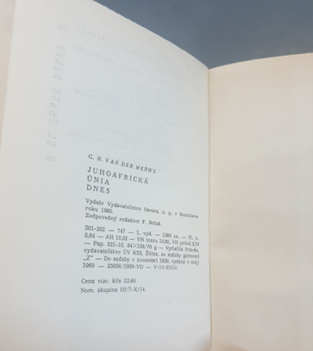


How could the publishing situation in Czechoslovakia during the period of 1945-1989 be summarized? Even though the rules were strict and the only contact with foreign authors had to be through government agencies, we can see a relatively huge diversity of genres, from children literature to world classics, such as Denník Anny Frankovej (Het Achterhuis, the diary of Anne Frank ). Paratexts, in the most diverse possible way, were a key element that helped books introduce themselves to the readers, offering them an escape into a totally different world. The following photos show some of the types of paratexts – the first photo is Záhrada medzi psom a vlkom (Een tuin tussen hond en wolf), written by Ivo Michiels. This is the back side of the cover, on which we can see photo of the author and a short text providing information about his name, place of birth, career and also the genre of his books. It does not forget to mention that he had been awarded many literary awards for his work. The second cover is of a book called Dedina pri rieke (Dorp aan de rivier), written by Antoon Coolen. Style of this cover looks more like a painting with a very specific art style.
(Richard Rúsek ed. Benjamin Bossaert)
Tags: Diversity, Literature and society, publishers
Link na DLBT: Criteria: 1. LANGUAGE (TARGET) = slovak, 2. LANGUAGE (SOURCE) = dutch, 3. YEAR BETWEEN 1945-1989
